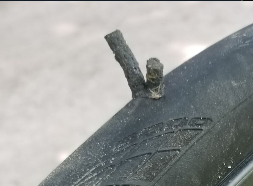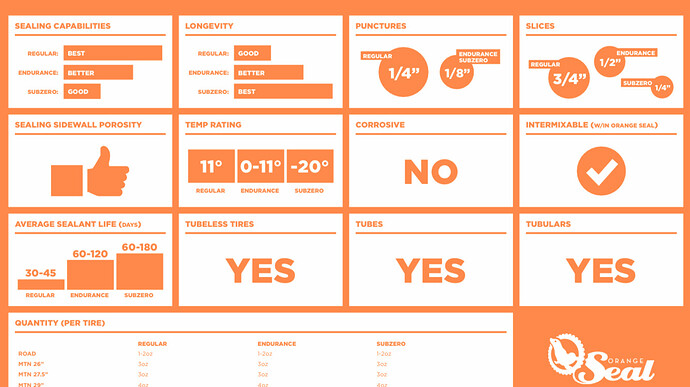Not a dynaplug, but last summer I got a slice about 3/8" on a (new, cough) gp5000tl 28mm.

I used the larger of the 2 strip sizes and did not trim. There is an equal amount of the plug inside the tire. It matted down on its own and slowly ablated away over time. Worked so well I continued to run the tire all year and into this spring until the tread was completely spent. No doubt I was tempting fate running it so long, but my experience is plugs are quite robust.
For those who don’t know, this plug type method of patching tubeless flats is nothing new or novel. Its how car tires are patched and has been in widespread use since tubeless car tires became standard equipment in the 1950’s.
Tubeless tires and hydraulic disc brakes - 100+ year old technology has finally made it to your bike ![]()
It is possible it was Muckoff and if that’s the case, your experience mimics mine to a T. Muckoff cannot handle road tire pressures, even with holes as small as a pinhole. I’ve personally found Orange Seal Endurance to work well for me. I run 25 mm tires at 70 psi and it’s been a night and day difference in my experience.
Thanks!
Me + the bike is about 270. I’ve run it lower bit it feels a bit squishy on steeper climbs.
Not sealing is one thing, but in talking to a few folks, that fact that I didn’t even see any sealant coming out the puncture is telling me the probably didn’t put enough sealant to start… that and carry my dart next time.
FWIW - this month’s Bicycling did a sealant comparison. I was disappointed they only used a mountain bike set-up, but what I noted is that some of the sealants need to be replaced as often as every 2 weeks. The average was probably about every 3 months.
As @RydeRuff12 noted, if it has been a while since you topped up the sealant, it could have dried out entirely so none of it would come out. Find out which sealant the shop used and check the manufacturer specs for how often you need to refill the tire.
In the case, it was a new tire and the shop installed it the week before I flatted. It may have been the type and they may not have added enough.
I’ve been going with the more is better method on sealant. I don’t want to get stuck somewhere because I tried to get by with 1 ounce of sealant. Plus I want a lot of leeway for evaporation.
Orange seal recommends 1-2 ounces for a road tire. I have been putting in 100ml (3 ounces).
Per tyre???
I’m using 40ml of the regular Orange seal, and they recommend topping off the sealant once a month (30-45 days):
That has worked well on 26c, 32c, and 35c road tires.
This is really important. I always use more than recommended. I currently use 120ml of squirt sealant per tire. I hear everyone has no success with finish line. I found that I had to use near double what they recommended and had a lot of success with finish line.
Also as others have mentioned you need to check your levels every so often. And if you use a latex based sealant, I’d recommend changing it every 3-4 months. Over time the latex sticks to the tire and leaves only water moving around in the tire. This can easily be checked with a syringe through the valve stem.
After a bunch of experiments, I’ve just used the “keep adding more” method. After a year on a rear GP5000TL, I really only had a 10 gram ball of latex snot in there and some liquid sealant.
I did try checking levels with the syringe through the valve stem but it seemed easier just using the sloshing sound method. Maybe I’ll try removing current sealant again as it’s time to top up.
I use a “dipstick” just like checking oil in your car.
I’ve tried that too. If what was said above is true (about latex dying leaving you only water) then the dipstick method might not tell you that your sealant will no longer work.
When I swapped my last tire, I only saw sealant inside, not water. I use Orangeseal. Maybe other sealants aren’t as good and separate easier?
I’ve been doing a diy sealant for years now. My understanding is it’s ammonia that keeps the latex from prematurely setting up inside the tire. Obviously ammonia is volatile, so it dissipates over time and the latex begins to set up all over the place. Not sure if some of the off-the-shelf varieties are using something fancier to keep the latex liquid, but I suspect initial ammonia concentration is one of the big factors in determining which sealants “go bad” fast or slow.
I’ve noticed a huge difference between a well sealed tire and a more porous tire.
On my road bike, I have GP5000TLs which have a butyl inner layer and the rims have no spoke holes. They are very well sealed and the sealant lasts a long time and when you take the tire off the entire inside isn’t coated with dried latex.
On my gravel bike, the tires are much more porous (sidewalls weep). I’ve been using Stan’s there and when I took the tire off, I practically had a latex tube in there covering every surface. I think that was actually a benefit. After several sealant top ups, the tire would develop better and better flat resistance. Where I rode, there were goat heads everywhere so every ride was 20 flats. The downside was frequent top ups of sealant.
I’ve done that too. But some sealants i find im left with basically just water. I changed squirt sealant (latex based) last week on my gravel bike. It came out pee colored (barely yellow and nearly clear). That sealant is white (stans like).
its hot & dry where I live, and during the summer months the dipstick method works well (evaporation). Based on past summers I’ve gotten lazy and simply top it off without checking, at the beginning of every month.
What sealant are you using in your gp5k?
